Weekly round-up: 28 May - 03 June 2014
The closing days of May and the opening days of June are rightly famous, perhaps the most potential-filled and eagerly-awaited days on the calendar – think Needle-tailed Swift, Ancient Murrelet, Pallas’s Sandgrouse………
This year the omens looked good, with, to start the week, a low pressure lurking close in to the East Anglian coast, a band of heavy rain slow-moving over eastern and then northern England and a steady easterly vector straight out of the Baltic. Such prime conditions persisted until 30th, after which an Atlantic high pressure nosed its way in to shut off the arrival window and calm things down a bit.
However, despite the east coast finally enjoying ‘fall’ conditions (after an otherwise lean month), the star bird was not in the east. Nor was it a passerine. At around 1000 on 31st May Paul Morton stumbled across what will be for many the bird of the spring - a superb ghostly Short-toed Eagle sitting in a pine tree at Morden Bog, Wareham Forest, Dorset. His first pictures portrayed a magnificent bird with all the right features - chalky white underneath, buffy on top with contrasting dark midwing panel and flight feathers, short-tailed with a fat, rounded-looking head (a function of expanded nape feathering) and big yellow irises. To the internet-living ‘summer raptor doubters’ this bird gave a resounding ‘two fingers’.
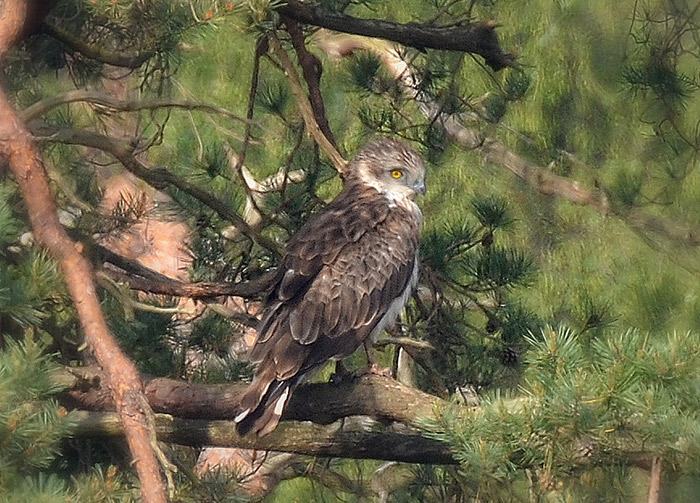
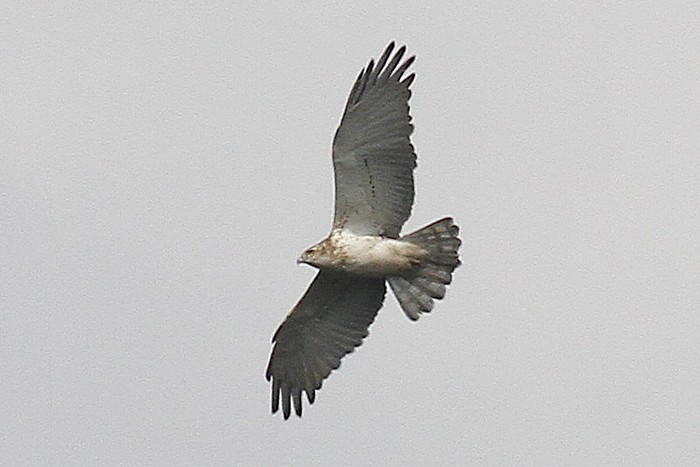

Though soon flying off, it returned to a pine tree in the late afternoon and then remained on view into the evening, enabling a growing crowd to enjoy it. Still there at dark, this was now a guaranteed early morning twitch for 1st and so it proved. It was watched from around 0440 to just after 1000 when it finally rose into the warming air, circled and headed off SSW. Despite rumours of it having been in the area for several days (and the hope, therefore, that it would return to roost once more), there were no further confirmed sightings.
Short-toed Eagle is a true bird of the Mediterranean, evoking thoughts of maquis-covered hillsides, cork oak dehesa and rolling steppe but, as are a number of other southern species, it is increasingly wandering to northern Europe too. Records are now regular in the Netherlands and, were it not for the Channel, it would doubtless be a more frequent bird here as well. Nevertheless, records are mounting. The first was the now-legendary bird on Scilly in the equally legendary October of 1999 (White’s Thrush, Siberian Thrush, Blue Rock Thrush…..), followed by another at Dawlish and Exmouth, Devon on 16th October 2011. This Dorset bird therefore becomes Britain’s third and the second twitchable. It also becomes the first in spring but on a date well after the main northward push into southern Europe (birds are already in Spain in mid-April).
The week’s second-best bird was, however, in the east though, bizarrely, it occurred not in the classic conditions of 28th to 30th but in the somewhat slack weather thereafter. Nor was it a bird from the east. Instead, it was another southern bird, indeed from the same source area as the Short-toed Eagle. It was a super singing male Spectacled Warbler , found at Burnham Overy Dunes, Norfolk on 2nd June and still present on 3rd, a classic ‘left field’ spring ‘overshoot’, a random bird apparently out of nowhere.
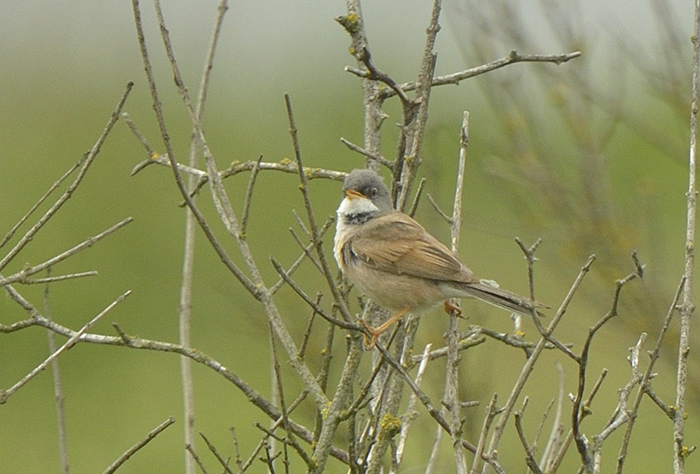
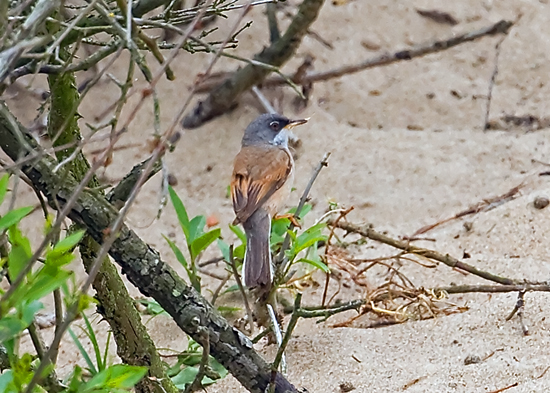
Though a little mobile, alternating between low bushes and a nearby belt of suaeda, it nevertheless showed well for all its visitors for the rest of the day, feeding within and under the vegetation, often hopping on the ground and regularly singing, occasionally doing so from a high, exposed perch. Here it showed to perfection its tiny, compact, spiky-billed, short-winged and narrow-tailed structure and its dazzling combination of grey head, inky ‘face’, big white eye crescents, russet-tinged upperparts, bright rufous upperwings with thin dark tertial centres, strongly-washed underparts, white throat and bright orangey legs. As ever, top marks and many thanks to the finder, in this case a highly fortunate Neil Alford. Finders generally get few thanks for their time and effort (but sometimes some unneeded hassle) so it’s great to be able to give credit here, not just to Neil but to the finders of all the birds this (and every other) week.
Read Neil Alfords account of finding the Spectacled Warbler here >>>
This constitutes the eighth British record and the second for Norfolk, following the equally gorgeous male on the adjacent Scolt Head Island on 6th May 2011. Most have been in spring (arrivals falling between 26th April and 3rd June) but two have been in autumn, both in October. Though now an established rare vagrant, Spectacled Warbler has had a troubled relationship with the British List, at first admitted on the basis of a bird at Spurn in October 1968 (later determined to have been a Subalpine Warbler) and subsequent birds at Porthgwarra, Cornwall in October 1969 and on Fair Isle in June 1979 (both later deemed ‘not proven’). The credibility barrier was finally broken, however, with the trapped, photographed and well-twitched male at Filey, Yorkshire in May 1992 which reinstated the species on the British List. This remains the most northerly record, all the others being in East Anglia or the South.
Previous Spectacled Warbler records in Britain
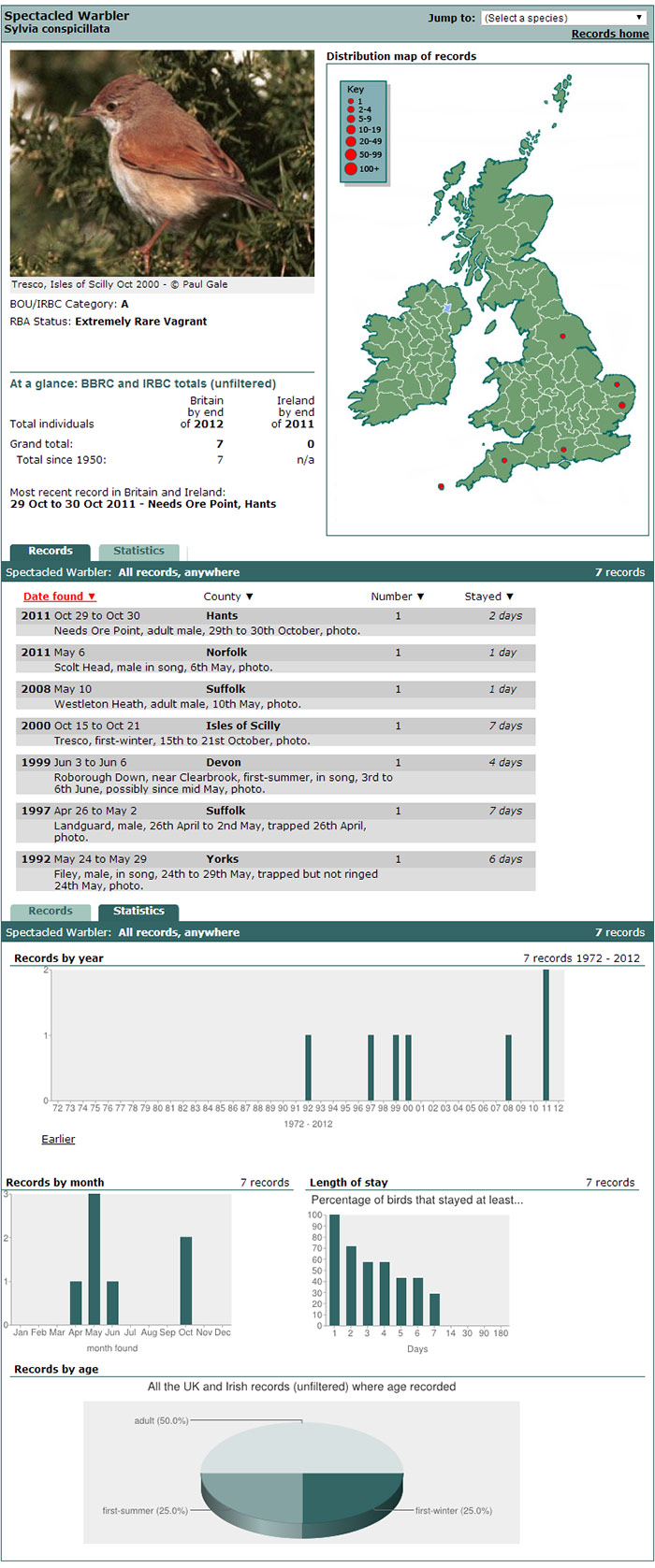
For the next quality bird of the week we go back to the Southwest, but this time not for another vagrant from the south but for one from about as far north as you can get. On 29th, a first-summer Ross’s Gull was identified at Bowling Green Marsh, Topsham, Devon, having been present for at least eight days masquerading as a ‘funny’ Little Gull. To be fair, first-year birds are not common in Britain, comprising only around 20% of all records so this is an unfamiliar plumage to most. Nor are May occurrences the norm, with only eight previous records in this month, so this was hardly an ‘on the radar’ bird. This constitutes the fifth record for Devon, the last on the Plym Estuary in January to March 2002. All previous county records have also been in this typical late winter slot.
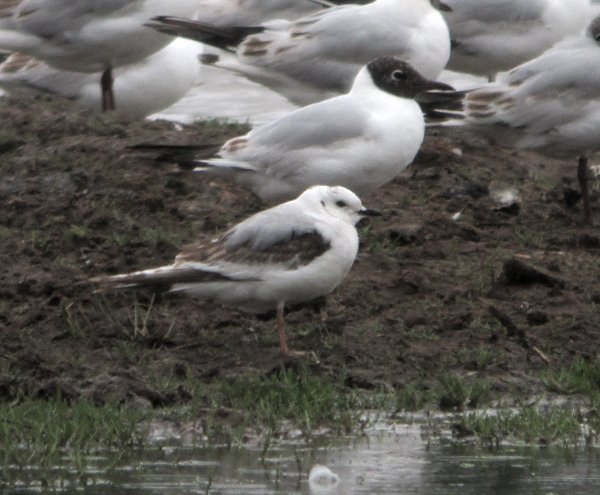
This truly iconic High Arctic species remained in situ until at least 3rd June, showing off its stubby bill, plain head, big, soft eye, long wings and diamond tail. Its long stay is already beginning to echo that of the last south coast Ross’s Gull in late spring/early summer – the famous lingering first-summer bird at Stanpit, Dorset from 16th June to 20th August 1974. With nowhere to go, might this bird now be in for the long haul too?
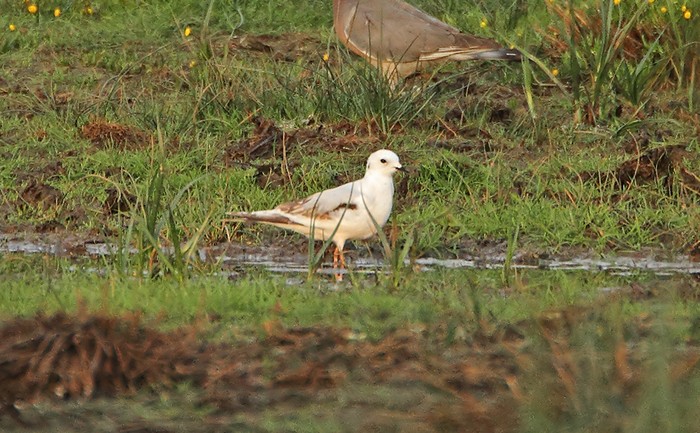
Late May/early June is, of course, the prime time for the Northern Isles (though, to be fair, Shetland has excelled already this spring, even by its own standards). On cue, therefore, Fair Isle pulled in its latest star passerine of the spring (added to the list which, remember, already features Cretzschmar’s Bunting, ‘Caspian Stonechat’, Hermit Thrush and Calandra Lark….). This latest addition was a stunning male Collared Flycatcher on the cliffs at South Naaversgill and Guidicum on 28th and 29th, not quite in the same league as those just mentioned but a top-class bird nonetheless and certainly ‘up there’ in the looks department. This was the 5th Collared Flycatcher for the fabled isle. The first (an autumn bird) was as recently as 1986, with further birds in 1998, 2004 and 2011.

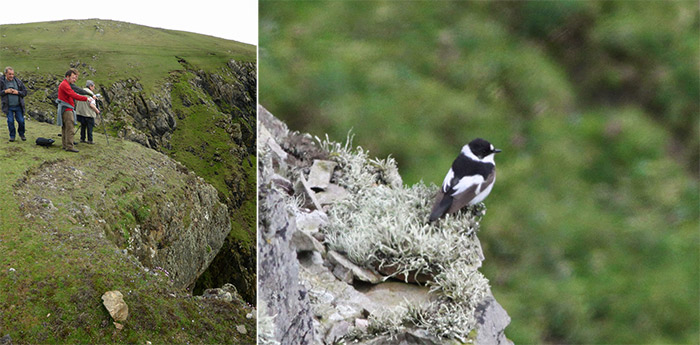
(© David Parnaby - Fair Isle Bird Observatory)
Meanwhile, its near look-alike - the variegatus Siberian Stonechat (or hemprichii if you prefer the proposed new nomenclature) - perhaps it’s easier to just call it ‘Caspian Stonechat’ - remained all week on the same island. Against all the odds, this bird really does seem to be taking up residence - a very lost bird indeed.
After the excitement of the Bermuda Petrel earlier in May, this week was somewhat quiet on the seabird front. We are now well past peak White-billed Diver time and the only bird reported was one at Dunnet Bay, Highland on 28th May and again on 3rd June. Only two Long-tailed Skuas were logged – one in the dramatic setting of St. Kilda, Outer Hebrides on 29th May, the other at the traditional spring skua venue of Bowness-on-Solway, Cumbria on 31st.
Glossy Ibises remained widespread. In Ireland reports came from Portmore Lough, Antrim, Lough Cowey, Down, Ballycotton and Cobh (2), both Cork, and Cahore, Wexford. In Britain singles were at Christchurch and Hengistbury Head, Dorset, Otmoor, Oxfordshire, Houghton Flash and Fairburn Ings, Yorkshire, Rutland Water Leicestershire, Hoveringham GPs, Nottinghamshire, Cambus, Forth and Martin Mere, Lancashire. Most far-flung of all, the Northern Isles bird continued to wander, being at Virkie, Shetland on 28th May and Sullom on 1st June.
.jpg)
At least nine Great White Egrets were reported, mainly at traditional sites in the south though one was at Askham-in-Furness, Cumbria on 28th May. Rarer herons included two Cattle Egrets at Tacumshin, Wexford on 28th May and three at Dungeness, Kent on 2nd June, Purple Herons at Marazion, Cornwall to at least 3rd June and at Hickling, Norfolk on 3rd, and the increasingly rare Night Heron at Bough Beech Reservoir, Kent on 30th.

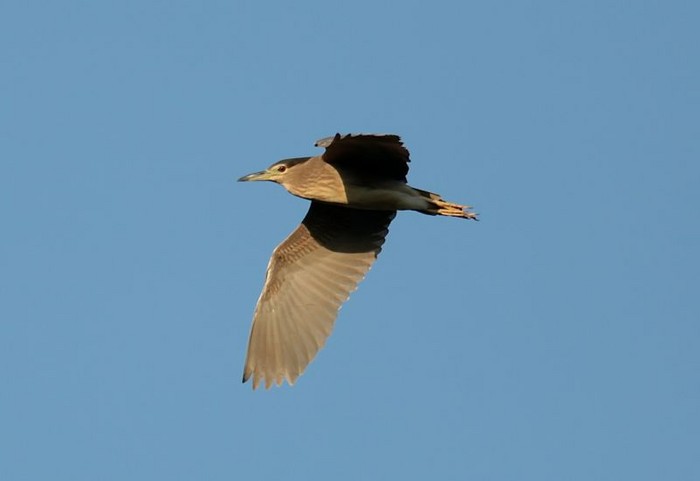
Finally, a Black Stork over Dawlish, Devon on 31st May added to south Devon’s impressive haul of birds this week whilst the week closed with another over Thornham, Salthouse and Kelling, all Norfolk, on 3rd June.
Wildfowl action was limited this week, the highlight being the continued presence of Frodsham’s second (and Cheshire’s fourth) Lesser Scaup to at least 3rd June. Elsewhere drake Green-winged Teals were at Tacumshin, Wexford from 28th May to 3rd June and at Ynys-hir, Ceredigion on 2nd. American Wigeons were at Loch of Strathbeg, Aberdeenshire on 1st June and at Loch Stiapabhat and nearby Loch na Muilne, Lewis to 1st June.
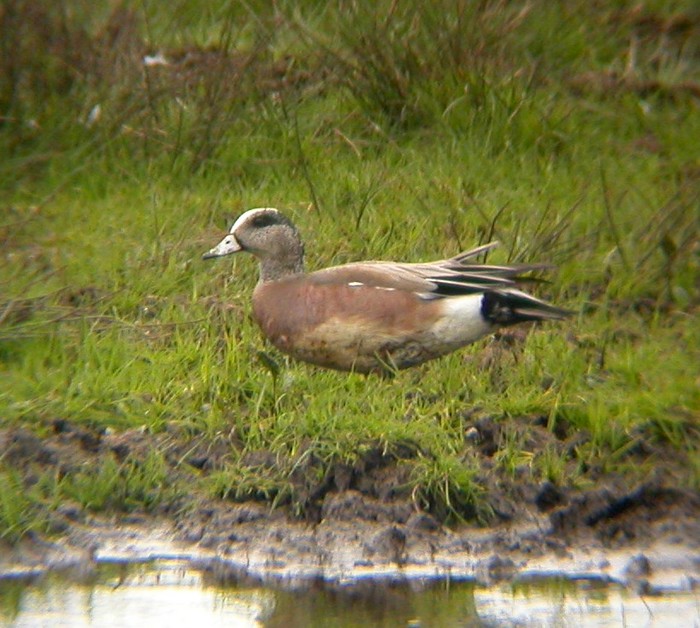
At sea, Surf Scoters were at Blackdog, Aberdeenshire on 28th May and in Dunnet Bay, Highland on 3rd June with a drake King Eider on the nearby Ythan Estuary, Aberdeenshire all week and a female at Musselburgh, Lothian on 30th May to 2nd June.
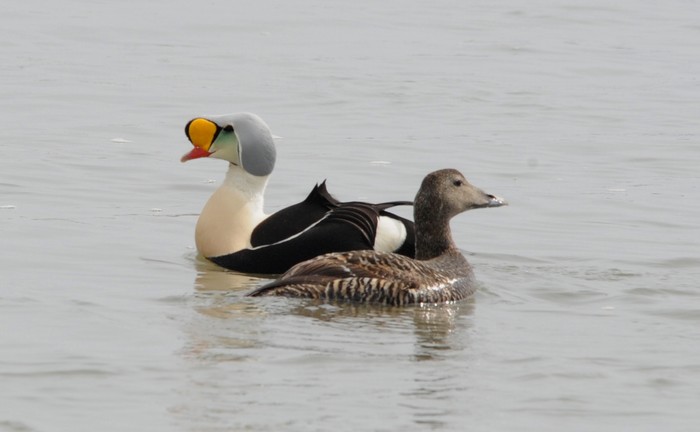
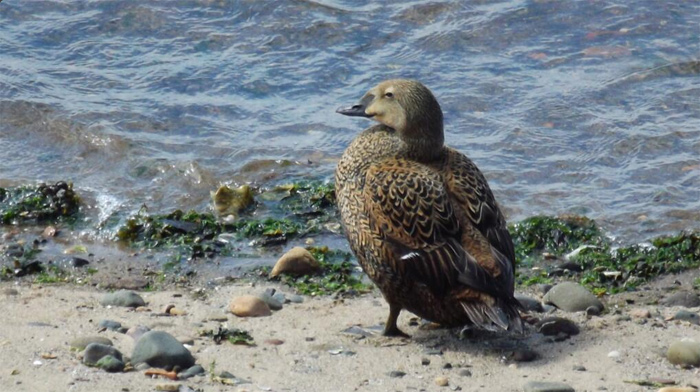
The ‘headline act’ in the waders section was of course the continued presence of breeding pairs of Black-winged Stilts at Medmerry RSPB, West Sussex and at Cliffe Pools, Kent. Elsewhere, another bird was as Finamore, Offaly on 28th May, with presumably the same bird at Clogheen Marsh, Cork on 30th and Clonakilty, also Cork, on 31st.
Migrant waders were otherwise thin on the ground in a relatively lacklustre wader season. The highlights were a Broad-billed Sandpiper at Holy Island, Northumberland on 30th May and an American Golden Plover at Tacumshin, Wexford on 1st June. Pectoral Sandpipers were at Newport Wetlands, Gwent on 28th May, on Unst, Shetland and Loch Stiapabhat, Lewis on 29th (the latter still in the area on 2nd June with 2 there next day) and at Trimley Marshes, Suffolk on 3rd. Also on 2nd to 3rd June, a Buff-breasted Sandpiper was at Cowpen Marsh, Cleveland.
Further south, Temminck’s Stints visited Hendre Lake, Glamorgan on 29th May and Lodmoor, Dorset on 30th, whilst Red-necked Phalaropes were at Slimbridge, Gloucestershire and Cotswold Water Park, Wiltshire on 29th, at Bowers Marsh, Essex on 1st June and at the Nene Washes, Cambridgeshire on 2nd.
The gull highlight of the week was undoubtedly Surrey’s first Bonaparte’s Gull – a first-summer at Staines Reservoir (and also at nearby King George V1 Reservoir) intermittently from 30th May to 1st June. A Ring-billed Gull was in Dublin Bay on 1st June.
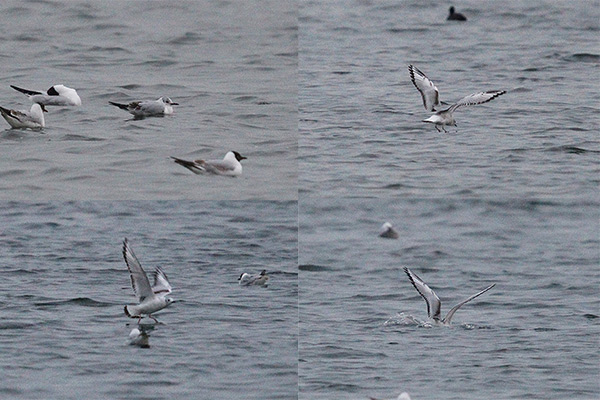
At least half a dozen unseasonal Iceland Gulls were logged, all in Scotland apart from singles on the Axe Estuary, Devon on 30th May and at Marazion, Cornwall on 1st June. Remarkably for late spring, a ‘Kumlien’s Gull’ was still on Fair Isle on 2nd June.
Rare terns were also rare, the only birds reported being a White-winged Black Tern briefly at Spurn with Common Terns on 29th and, best of all, Whiskered Terns at Bowling Green Marsh, Devon on 31st and on North Uist, Outer Hebrides on 3rd June. Surely this is the first time that a Whiskered Tern and a Ross’s Gull have been present simultaneously at the same site?
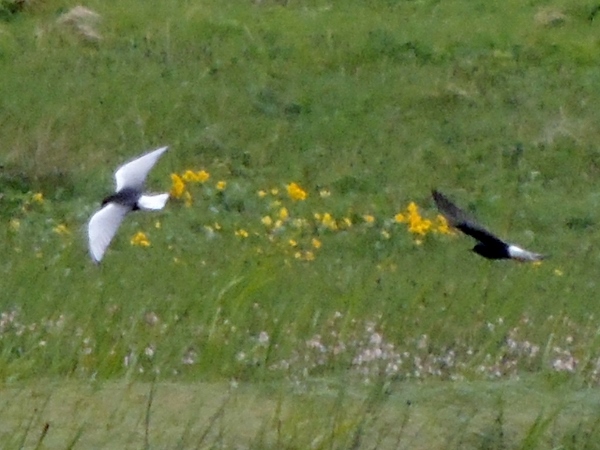
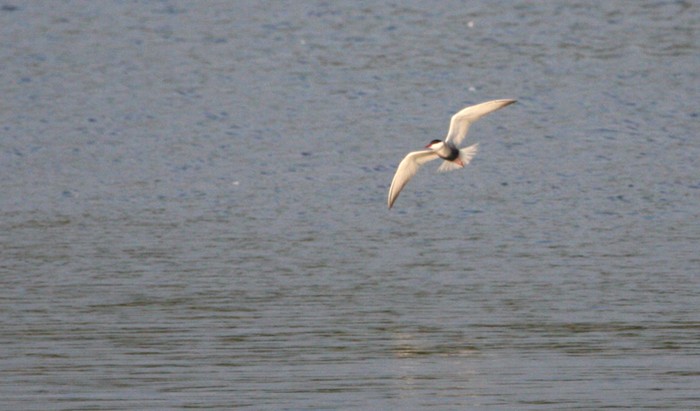
Remarkably, a Pallid Swift was noted passing south at Spurn, Yorkshire on 31st May. This sighting breaks the now-established mould of late autumn (with a few early spring) occurrences. The first British record (at Stodmarsh, Kent in May 1978) was at this time of year but they have been few and far between (only ten records) at this season ever since. Are we overlooking them amidst the hordes of our own Common Swifts?
To the far north, Alpine Swifts were at Birsay, Orkney on 29th May and at Westburn Park, Aberdeenshire on 30th.
Black Kites were present at Hildenborough and Kingsdown, both Kent on 29th May, Brenchley, also Kent, on 31st and Bolderwood, Hampshire on 1st June. Further reports came from Dungeness, Kent on 2nd June and Trimingham and Waxham, Norfolk and Lewes, Sussex on 3rd.
.jpg)
A Honey Buzzard returned to display at the traditional site of Wykeham Forest, North Yorkshire on 30th May, whilst elsewhere, five migrants overflew Dungeness, Kent between 28th May and 2nd June, with others were noted over Aberdeenshire on 29th, Fair Isle, Highland, Lincolnshire and Suffolk on 30th, Dorset and Lincolnshire on 31st, Cambridgeshire, Hertfordshire, and Kent on 1st.


Wandering Montagu's Harrier were noted in Kent (Foreness Point on 2nd June), Norfolk (Salhouse on 2nd and Cley on 3rd June), and in Suffolk (lingering at King's Fleet until 30th May).
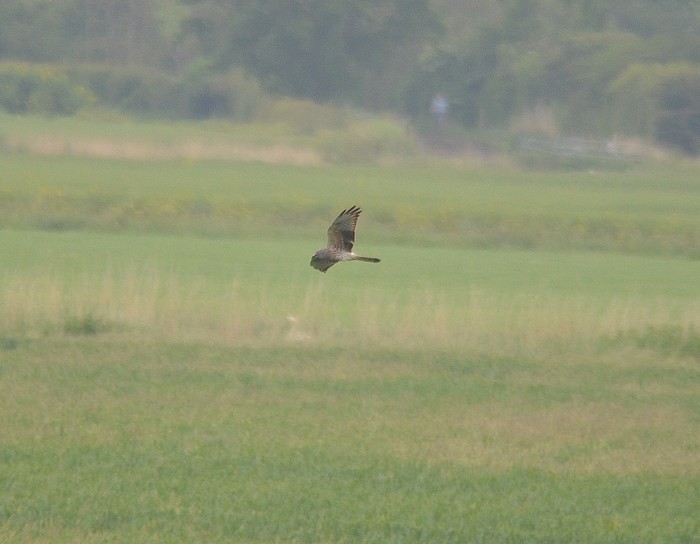
In England single White-tailed Eagles were reported near Longtown, Cumbria on 29th May, and at Wykeham Forest, North Yorkshire on 1st June.
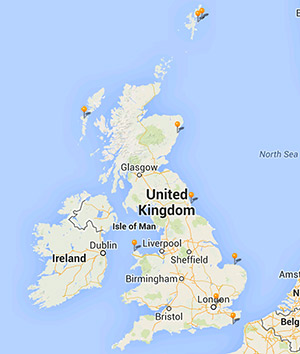
Despite the headlines being dominated by non-passerines in the Southwest, the top story of this week was really the ‘fall’ of scarce and rare passerines on the east coast. After a month pretty much completely lacking any suitable vector, the conditions at the start of the week were a godsend, and in the best week of the spring too!
Things took a while to get going, however. Heavy rain on 27th across East Anglia had dampened spirits and provided few hints of birds to come so it was a relief indeed when birds finally appeared on 28th.
Perhaps the most notable feature of the week was the continuing appearance of Blyth’s Reed Warblers in a now-record spring influx of the species. Singles were on Out Skerries, Shetland on 28th May and Whalsay, also Shetland, the same day, the latter still present on 29th. The action was not confined to the far north, however. Indeed this spring’s arrivals have been notable for their wide scatter. As if to prove the point, Dungeness, Kent also recorded one on 28th with, more remarkable still, one at Wanstead, London on 29th. Subsequent birds were at Torrey, Aberdeenshire and Cemlyn, Anglesey on 31st, at Whitburn, Durham on 1st June and at Cley, Norfolk on 2nd. This species is still clearly on the rise, this spring’s influx surely sending it ever nearer the ‘non BB rarity’ zone. How remarkable is that?
Greenish Warbler is the other classic end of May/early June ‘drifter’ from north-east Europe and western Russia and it was no surprise to see some arrivals of this species too, with singles at Blakeney Point, Norfolk, Whitburn, Durham and Newbiggin, Northumberland, all on 29th, with further birds at Donna Nook, Lincolnshire and Durlston Country Park, Dorset on 30th and Sand Point, Somerset on 2nd June. The ‘fall’ conditions this year have brought some to the east coast but in many ways the Somerset bird is more typical. This is a bird which normally reaches the far West as a fine weather ‘overshoot’ in early June, with the Irish Sea observatories particularly well served with records.
The rarest passerine to come out of the ‘fall’ conditions was the female Black-headed Bunting at West Runton, Norfolk, found on 28th and present to 1st June. With comfortably over 200 British records, this was, surprisingly, only the fourth for Norfolk, and came hot on the heels of the male seen at a garden feeder in nearby Cromer only days before. With the last county record being as long ago as 1989 (a September first-winter on Blakeney Point), this was a much-wanted bird for many in the county. This is, like Greenish Warbler, another bird with a habit of overshooting eastern Britain in spring. Records are often in the far West or Northwest but, like the warblers, this bird was also forced into a premature landfall by the inclement weather.
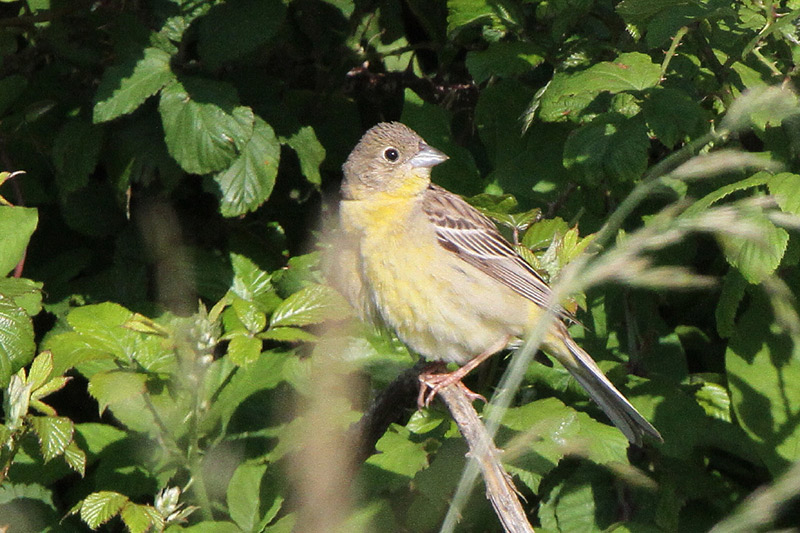
Also caught up in the cross-North sea ‘drift’ was an Eastern Subalpine Warbler on Blakeney Point, Norfolk on 28th May, with further ‘Subalpine Warblers’ at Spurn, Yorkshire the same day and at Papa Westray, Orkney on 1st June. Given the likely further split of the Subalpine Warblers, it has become more important than ever to document these birds as comprehensively as possible - all three taxa (Western Subalpine, Eastern Subalpine and Moltoni’s Warblers) will be ‘BB rarities’ from January 2015.
Rustic Buntings also appeared on cue. Two were entirely typical in both timing and location - at Skaw, Unst on 30th May with one still on Out Skerries - but another (a brief female) was at Happisburgh, Norfolk the same day and then another (a singing male) was on Tiree, Argyll on 2nd and 3rd June - just the latest addition to a fine run of birds on this island this spring.

Much rarer these days (a potential returner to the ‘BB rarity’ list?) is Red-throated Pipit . Despite the suitable vector, only one was noted – at Hermaness, Unst on 1st June.

Accompanying these ‘headliners’ was an impressive arrival of the traditional late spring northern European ‘drifters’. Top of the list in numbers terms were Red-backed Shrikes , with at least 45 scattered around the usual east coast venues. North Ronaldsay, Orkney did best with eight in a day though Fair Isle managed a highly respectable six.
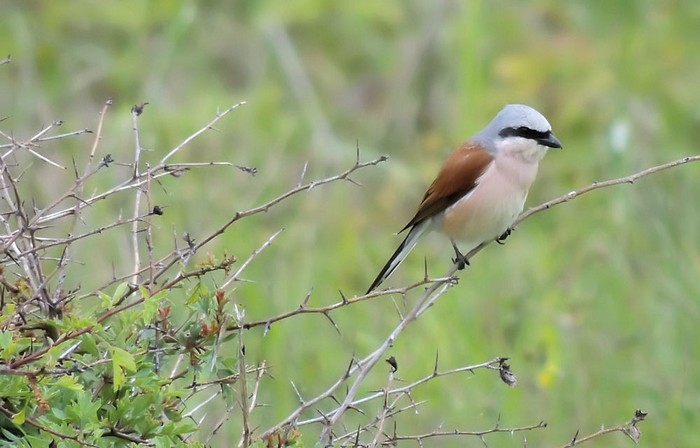
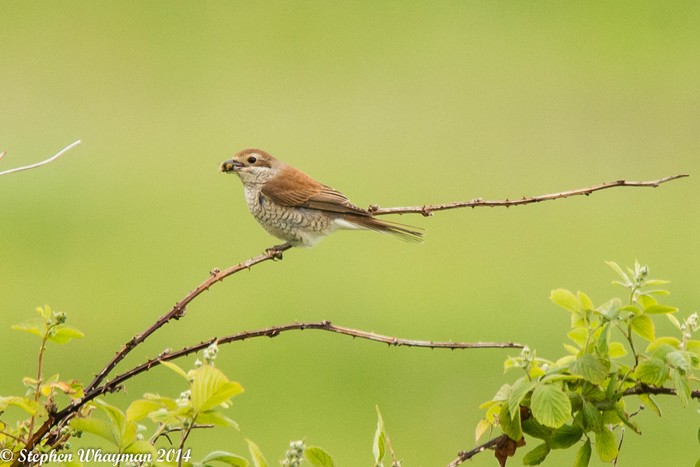
Next in line were Icterine Warblers , with around twenty logged, again all at traditional locations. About a dozen Marsh Warblers also appeared on cue, almost all in the east or south but singles reached Tiree, Argyll on 28th May, Bardsey, Gwynedd on 30th and, furthest of all, Port Nis, Lewis on 2nd June. The list was completed by half a dozen Golden Orioles and Common Rosefinches (with one of the latter also on Tiree!), a similar number of Red-breasted Flycatchers and a couple of Wrynecks . Finally, a Bluethroat was at Spurn, Yorkshire on 29th and 30th May and an increasingly rare Ortolan Bunting was on Out Skerries, Shetland on 30th and 31st.
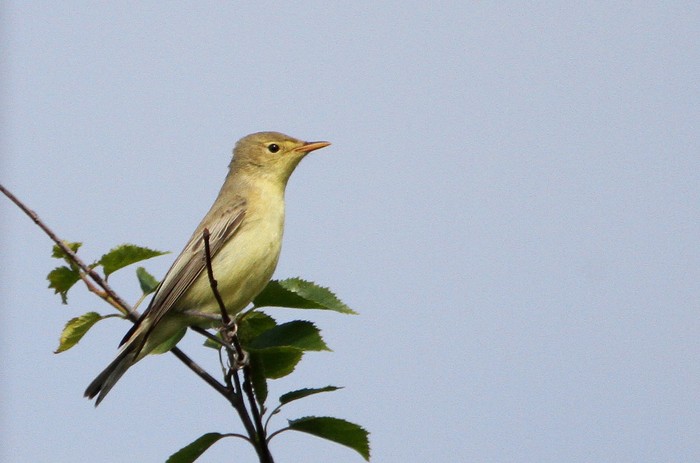
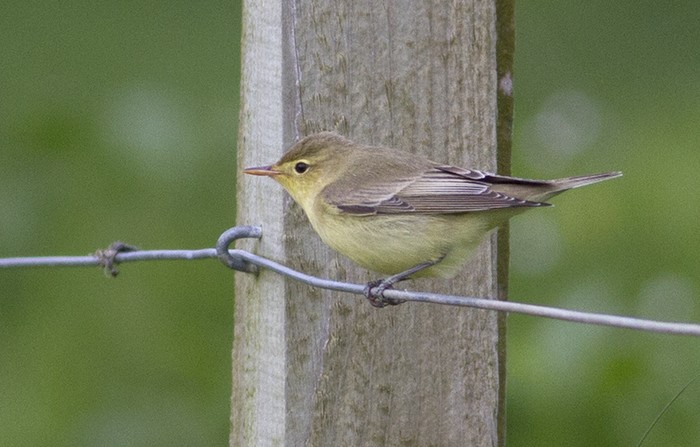
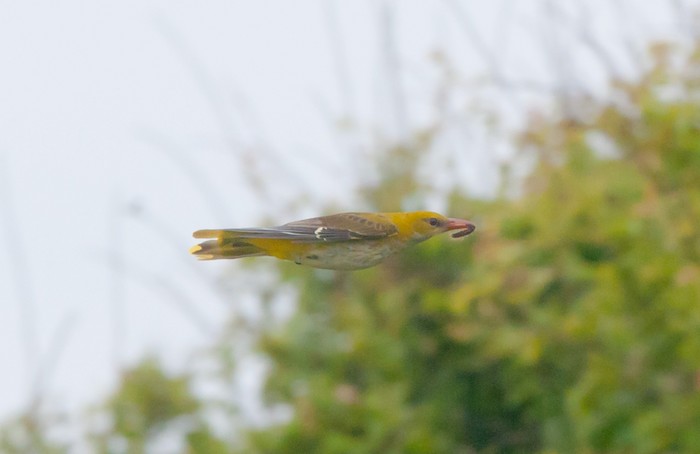
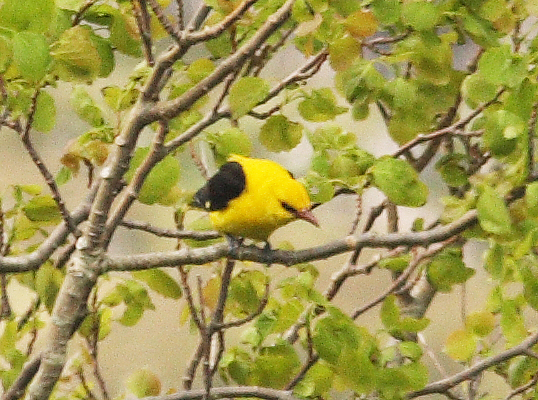

Bee-eaters were the other notable feature of the week, with singles and small parties widely scattered though, as ever, most were brief and some only heard. The three which lingered in the South Gare, Cleveland area from 29th to 31st May were therefore very well received. All reports were as follows: 28th May - St. Catherine’s Point, Isle of Wight and 4 still Portland; 29th - Dales Voe, Shetland, Teignmouth, Devon, Durlston Country Park, Dorset, Bury, West Sussex and 3 South Gare, Cleveland; 30th - Scabbacombe Head, Devon, 2 Blakeney Point, Norfolk and 3 Cleveland still; 31st - 3 Cleveland still, 4 again Portland and 4 New Forest, Hampshire and single Prawle Point, Devon; 1st June - 4 Charmouth, Dorset, 2 Dungeness, Kent, single West Kirby, Wirral and 5+ Axmouth, Devon; 2nd June - 2 Ilchester, Somerset and 5 Lymington, Hampshire; 3rd June - 2 Isle of Wight and 5 Havant, Hampshire.
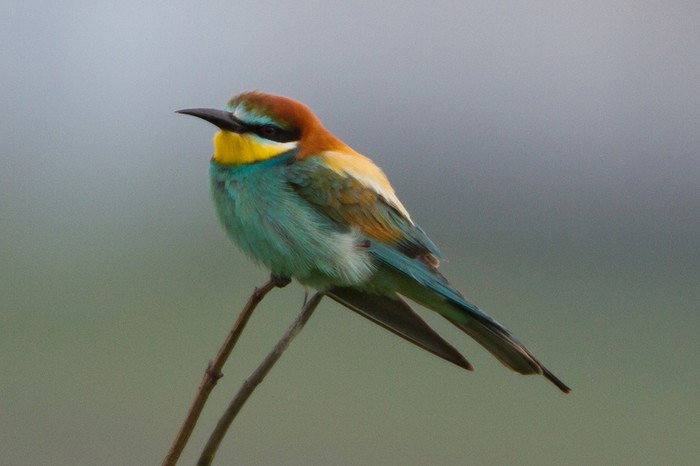
The passerine line-up is completed by a Great Reed Warbler at Vidlin, Shetland on 3rd June, Savi’s Warblers at Newport Wetlands, Gwent on 28th May to at least 3rd June and at Loch of Strathbeg, Aberdeenshire on 29th May to at least 3rd June also, a male Citrine Wagtail at Burniston, Yorkshire on 2nd June, Woodchat Shrikes at Hummersea, Cleveland to 1st June and at Foreness Point, Kent on 2nd, a Short-toed Lark still on Fair Isle on 30th May, Grey-headed Wagtails at Minsmere, Suffolk on 28th May, Happisburgh, Norfolk on 30th, Studland, Dorset on 31st and Fair Isle on 2nd and 3rd June, a Rose-coloured Starling at Rochester, Kent on 29th May, and West Bexington, Dorset on 31st, a Serin at Brighton, Sussex on 1st June and Hoopoes at Oldmeldrum, Aberdeenshire from 30th May to 3rd June and at Crediton, Devon on 2nd.
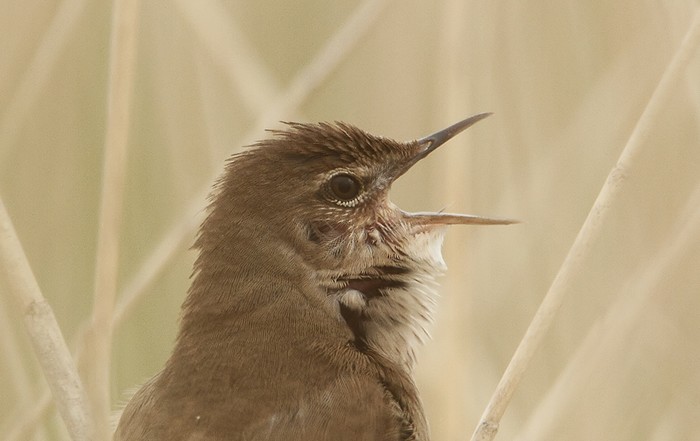
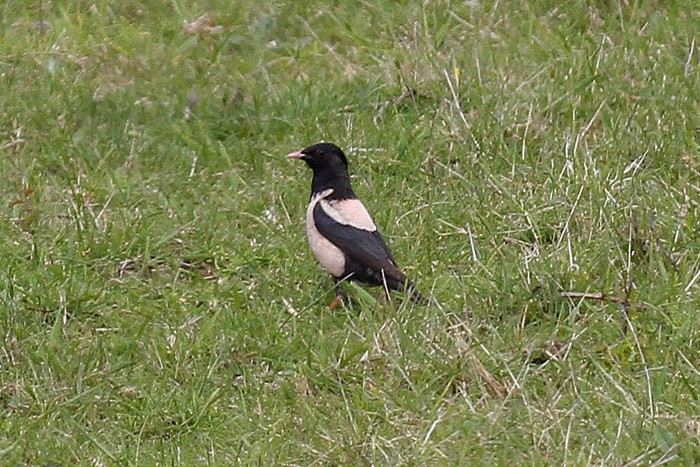
The coming week is still top rarity time and, given the predicted weather charts, it may be time for the Northern Isles to recover from a relatively quiet week and come up with something truly surprising. Or maybe Heligoland’s Black-browed Albatross will discover Bempton…
Andy Stoddart
04 June 2014
Many thanks to all our contributors for their photos, videos and sound recordings.
Contributors websites












